Malaysia 2019 Part 3: The road to Long Semadoh
Far too early on Sunday the 23rd, Otago team A bid a sleepy farewell to Kuching and hailed a convoy of cabs to the airport bound for Miri. Meanwhile, some 7800km away, Otago team B boarded flights to Singapore. For both teams this was the first leg of a journey to the same destination: a town of ~1900 citizens in the middle of the Sarawakian jungle, Long Semadoh.
From Miri, team A took a 45 minute, 20 seater flight to Lawas where we met the multi-talented Dolphina. Dolphina was facilitating our stay with her family in Long Semadoh and would be our ever-patient guide, host, and mentor over the next week.
From Lawas, the team assembled in two trucks for the 4 hour logging-road hill-climb to the village. In recent years the road has been re-graveled and pressed- prior to that, it could take a convoy of trucks 3 days to reach Lawas from Long Sem. From my vantage in the covered bed of the truck, I was deeply grateful for the investment in infrastructure.
Upon arrival we were greeted by several members of the community- friends and family members of our hosts, teachers from the local school, and various members of the community just curious about the arrival of two Hilux’ full of stunned New Zealanders.
We were graciously invited to stay in the headman’s house where we made ourselves at home before driving down to check out the local school. The first impression from Dave Warren, after five years of chemistry outreach, was that it might be the most beautiful school we have visited yet. Hibiscus, orchid, and red fan palms flank the covered walkways; a bamboo sided hut built over a pond serves as a relaxation area for the teachers; over the netball court, a temporary structure had been built to serve as our lab in the days to come.
This blog will be updated periodically as the trip progresses, but you can also keep up with the team on facebook, twitter, youtube, and Instagram at the following URLs
Otago chemistry outreach page: https://www.facebook.com/chemotago/
Youtube: https://www.youtube.com/channel/UCvEnYDv1AdrA016_E86Fj0w
Twitter: https://twitter.com/chemotago
Instagram: https://www.instagram.com/chemotago/
Malaysia 2019 Part 1: Kemasains in Kuching.
Here we are again, back in our favourite city, Kuching in Sarawak. It’s a great place for outreach, with lots of old friends from IPG Batu Lintang and new students to work with.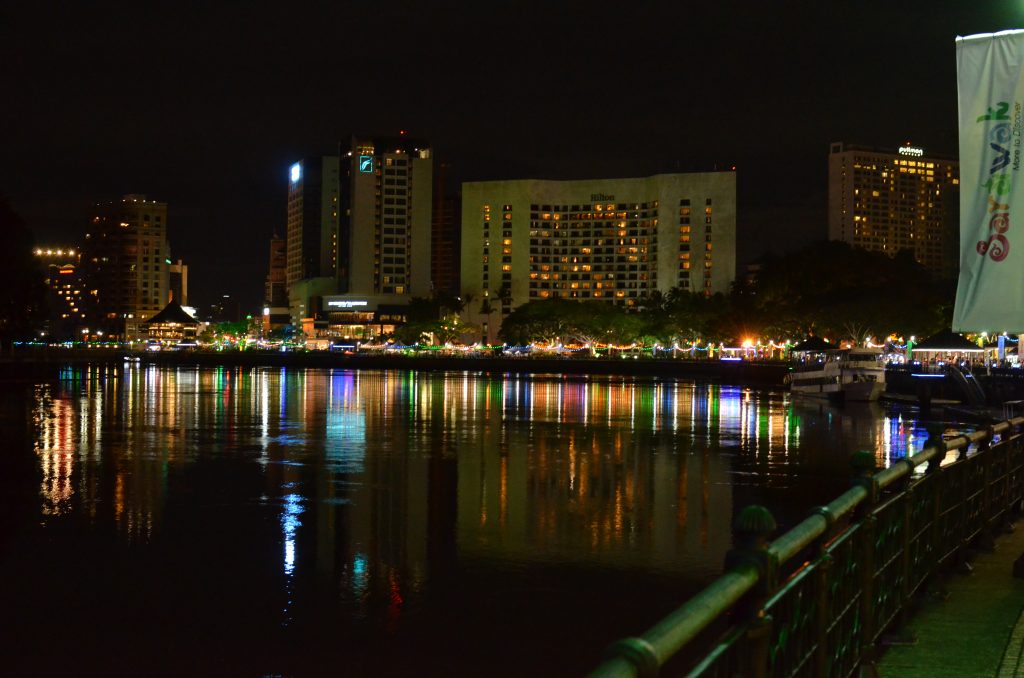
First day activities today were briefing the IPG student teachers who were going to be supporting us for the rest of the week and then preparing and packing for the Kemasains activities later in the week
It was a hot day for a team just arrived from chilly NZ but everyone was relaxed and happy to be back in what feels like our second home
Outreach in Malaysia
An article about our pivotal trip in 2016 to a remote school in the jungles of Sarawak and published in Science magazine on 21st September 2018
.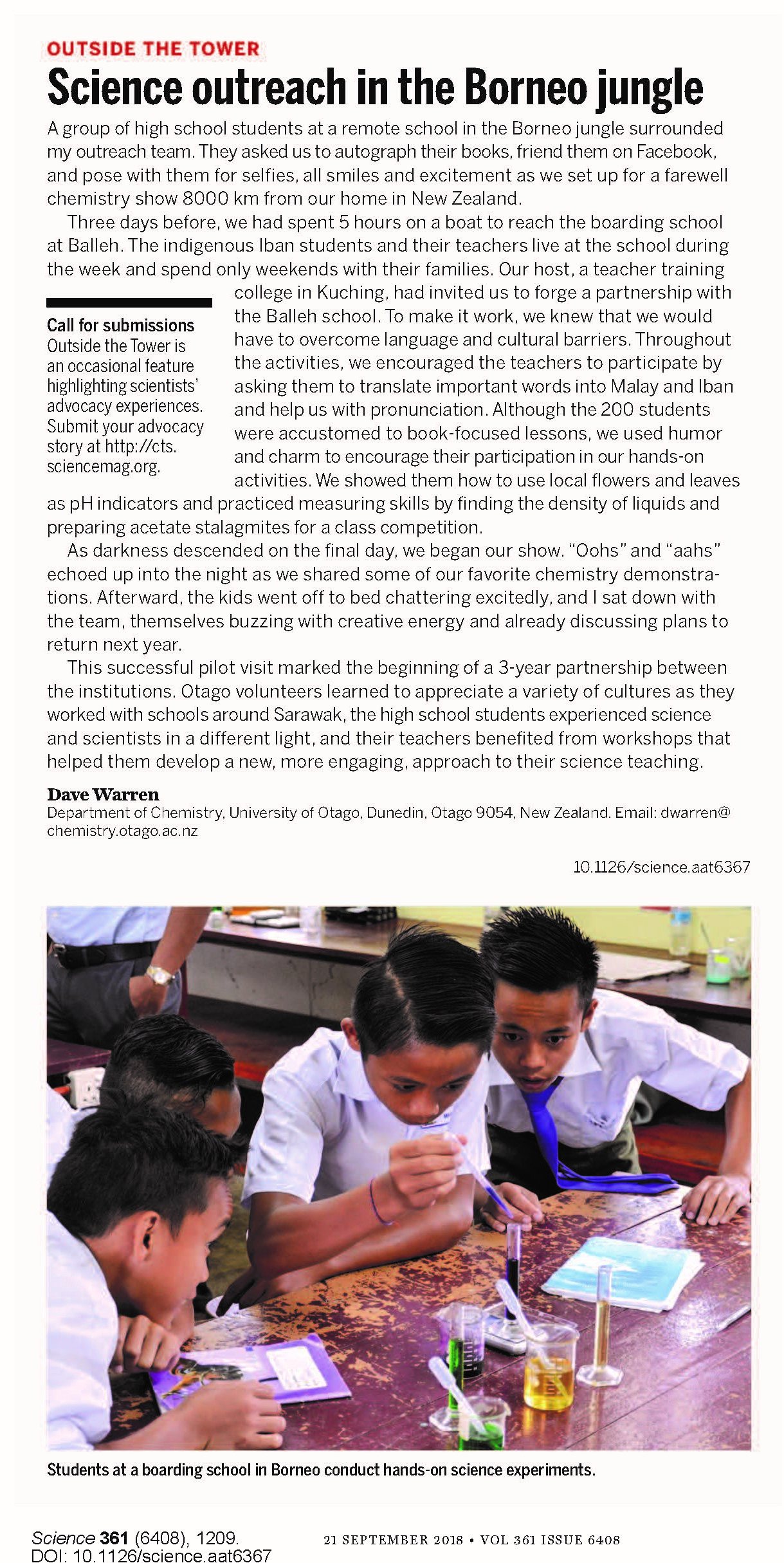 Signing autographs and taking selfies on our final evening;
Signing autographs and taking selfies on our final evening;
Chemistry Outreach in Malaysia: Part 4 Teaching
And that’s it for this year, two full on weeks in the heat and sunshine in Sarawak, great things to see and buy, great food and above all great kids and teachers to work with.
On the last day of the trip (and her last day working for the Chemistry Dept.) the amazing Marina Roxburgh summarises the trip.
We hope you’ve enjoyed following us on the blog, feel free to contact us and keep in touch
Otago chemistry outreach page: https://www.facebook.com/chemotago/
Youtube: https://www.youtube.com/channel/UCvEnYDv1AdrA016_E86Fj0w
Twitter: https://twitter.com/chemotago
Instagram: https://www.instagram.com/chemotago/
Chemistry Outreach in Malaysia part 3: kids
At the end of our first week in Sarawak we visited our only primary school on this trip, at SK Batu Lintang. On a HOT HOT day the kids were so excited by the visit and wanted to try everything immediately.
It made for a hectic session and everyone was drained by the end but just look how happy the kids were. Listen to Sam McIntyre and the kids explain what we got up to in this video.
Otago chemistry outreach page: https://www.facebook.com/chemotago/
Youtube: https://www.youtube.com/channel/UCvEnYDv1AdrA016_E86Fj0w
Twitter: https://twitter.com/chemotago
Instagram: https://www.instagram.com/chemotago/
Chemistry Outreach In Malaysia Part 2: Parents
Back home in Dunedin, Chemistry Outreach team member Geoff Weal hosts a drop in science session called “Science for supper” for kids and their parents. The idea behind science for supper is for parents to share and understand the excitement that their kids get from science, so that they might better understand it and follow it up in the home. This year the team has their first opportunity to work with the parents of some of the local students, so they’re bringing science for supper to Malaysia.
In the covered central walkway of the Sarawak IPG, the outreach team sets up nine stalls- each showcasing a different experiment: The chemists man a cauldron of fire, create pH indicators from red cabbage, coach sodium acetate into stalagmites, generate vast quantities of PVA borax slime, and create artwork from cyanotypes and chromatography. The physicists create LED torches from scratch, use polarised lenses to explain how light behaves, and hold a modest disco in a darkened room. The day has an air of the carnival about it, and Geoffrey Weal walks tall between stalls, beaming like a ringleader.
The bog standard science-for-supper session is for both kids and parents, so there was some concern that the parent attendees wouldn’t be as enthusiastic without their children to stoke the enthusiasm. We needn’t have worried. Shrieks of laughter echo up and down the bustling atrium, and the figures leaving each crowded stall are eager to see what’s happening at the next.
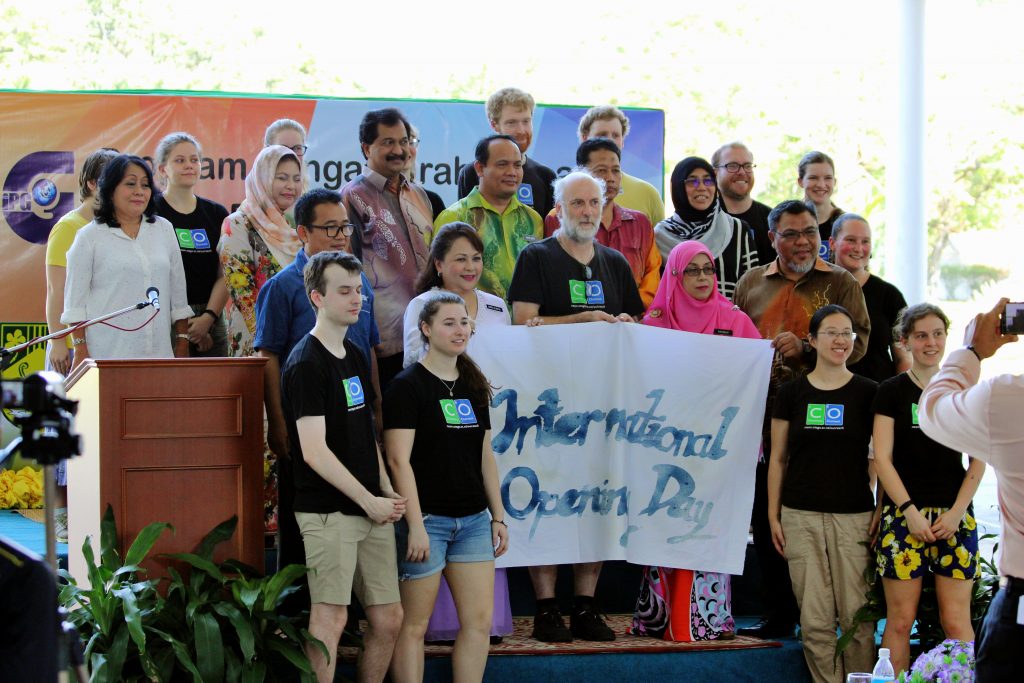
The Chemistry Outreach team poses for a photo at the Sarawak IPG before their Science For Supper session
You can see Dave Warren and Geoff Weal talk about their experience, and give some background about science for supper at the following video: https://www.youtube.com/watch?v=NoGstSY5Dn8
This blog will be updated periodically as the trip progresses, but you can also keep up with the team on facebook, twitter, youtube, and Instagram at the following URLs
Otago chemistry outreach page: https://www.facebook.com/chemotago/
Youtube: https://www.youtube.com/channel/UCvEnYDv1AdrA016_E86Fj0w
Twitter: https://twitter.com/chemotago
Instagram: https://www.instagram.com/chemotago/
Chemistry Outreach In Malaysia Part 1: Reunion
Another week, another flight itinerary. On Sunday the outreach team gathered at the Taipei airport to see off Jinaya, Savanna, and Steve before heading off to Kuching via Kuala Lumpur. Jinaya and Savanna were somehow bumped to an earlier flight than Steve. The plane carrying the rest of the outreach team was late, delaying our connecting flight. Ultimately everyone ended up in the correct country; Steve, Jinaya and Savanna made it home safe and sound while the remaining outreach team collapsed gratefully into their hotel in Kuching, Sarawak.
The differences between Taipei and Kuching are striking. Kuching is tiny in comparison to Taiwan’s tech giant mega-capital, but what it lacks in size it makes up for in flamboyant character. The city’s name is a homophone for the Malay word for cat “kucing”, although history is hay on whether or not this is a coincidence. Regardless, the city has embraced the soundalike, and is adorned with vast statues, murals, ornaments and shrines to its furry denizens.
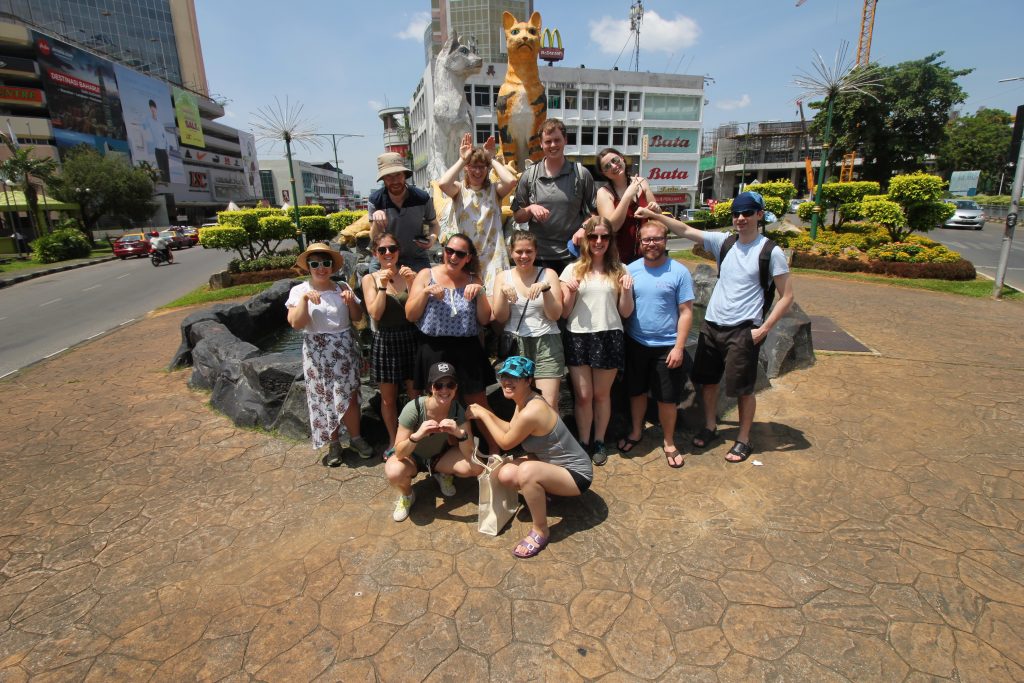
The Otago Chemistry Outreach team and the Otago Optics Chapter pose in front of one of Kuching’s many cat statues
The city is bisected by the Sarawak river, where locals and tourists alike gather to eat under a rainbow of LED adorned vendors in view of the flora-form parliament building. The rest of the city is a wild mix of Indian, Chinese, Muslim, and colonial English architecture with infrastructure to match. The footpaths rise and dip between store fronts, morphing between tiles and concrete, and sometimes disappearing completely. To call it a city of contrasts would be to imply stark differences; Kuching is the city equivalent of a spilled bucket of lego, in the best possible way.
Cats and laksa vendors aside, Kuching also holds some people very dear to our heart: Matt, Petra, and Bianca of Otago’s Optics chapter. The optics chapter is a student run society that also participates in outreach, as well as community engagement and professional development. They will be joining us for two busy weeks in Malaysia as we meet with local schools and teachers’ colleges (“IPG’s”) to continue an international education outreach relationship that is entering its fourth year. You can learn more about the Optics Otago team at the following video: https://youtu.be/yXYng-MqgW0
This blog will be updated periodically as the trip progresses, but you can also keep up with the team on facebook, twitter, youtube, and Instagram at the following URLs
Otago chemistry outreach page: https://www.facebook.com/chemotago/
Youtube: https://www.youtube.com/channel/UCvEnYDv1AdrA016_E86Fj0w
Twitter: https://twitter.com/chemotago
Instagram: https://www.instagram.com/chemotago/
Chemistry Outreach In Taiwan Day 6: Farewells
Friday was the last day of the Madam Curie Science camp, and also our last day with three of the Outreach team members: Steve, Jinaya, and Savanna.
Steve’s contribution to the trip was enormous, acting as coordinator and MC of the cyanotype printing workshop (as demonstrated in the previously blog entry). He’s also just bloody hilarious, and an asset to any outing.
Savanna and Jinaya, year 12 and year 13 high school students respectively, had a different role: they were attending the camp as students. They share a few words on their time at the Madam Curie Chemistry camp in the following video: https://www.youtube.com/watch?v=0wlXGweanRA
With the camp at Taiwan drawing to a close, we have set our sights on our next destination: Sarawak, Malaysia. The Outreach team will be spending two weeks their, working with students, parents, and teachers alike to promote international and interdisciplinary diversity.
This blog will be updated periodically as the trip progresses, but you can also keep up with the team on facebook, twitter, youtube, and Instagram at the following URLs
Otago chemistry outreach page: https://www.facebook.com/chemotago/
Youtube: https://www.youtube.com/channel/UCvEnYDv1AdrA016_E86Fj0w
Twitter: https://twitter.com/chemotago
Instagram: https://www.instagram.com/chemotago/
Outreach in Taiwan Day 5: Experimental
Thursday morning dawned on a damp but unharmed Aspire resort. Typhoon Maria, thankfully, petered out before reaching the south-western edge of Taoyun city, and the day begins optimistically with various detectors reporting above 6 on the UV index. A bright-eyed Outreach team sets to work on last minute preparations: Tying string around table legs for DIY drying racks; converting bathrooms into acetate developing stations; labeling the lids of 44 tiny spray-bottles.
1:30 pm rolls around and the Madam Curie students file into a hall of pre-assembled cyanotype kits. After much shuffling about and donning of lab coats, Steve Ting takes to the mic like a rockstar in the world’s least likely venue.
“Hello!” He bellows
“Hello!” Reply the students
“That was terrible, do it again,”
Steve charms us through the history of the cyanotype print, along with instructions on how to develop their own images and the assurance that he is not, in fact, a chemist. With translation assistance from Jacqui Kao, the students are off, busying themselves with the combination and application of the photochemical solution. The developing pages are soon shuffled off into drying rooms and the real work starts: the students have to design their own images to develop.
We made the decision to provide our own acetate slides and leaves in case students didn’t feel engaged enough to make their own designs. This contingency was entirely unnecessary. Within minutes the Aspire hall was roaring with students drawing freehand, modifying the acetate slides, or tracing using their phones as lightboxes. I helped a student track down some cellotape so he could secure a palm frond in the shape of a mandarin character.
As the students persist with their designs, a teacher sneaks past the back of the hall holding something: she quietly finished up the process ahead of the students.
Success. The UV index shows an 8, and the UV exposure stage can go ahead without resorting to metal halide lamps indoors.
With the experimental method confirmed, the rest of the afternoon is a blur of students crowding outside to expose their prints, develop them, and show them off proudly on social media.
You can check out the students’ amazing work, and an absolutely stoked outreach team in the following video: https://www.youtube.com/watch?v=zJ5JwIsSpo0
This blog will be updated periodically as the camp progresses, but you can also keep up with the team on facebook, twitter, youtube, and Instagram at the following URLs
Otago chemistry outreach page: https://www.facebook.com/chemotago/
Youtube: https://www.youtube.com/channel/UCvEnYDv1AdrA016_E86Fj0w
Twitter: https://twitter.com/chemotago
Instagram: https://www.instagram.com/chemotago/
Outreach in Taiwan Day 4: Prep
Completing the chemistry quiz crossed off one of the team’s two major activities at the camp, the other being rather more involved in terms of preparation; tomorrow the team will facilitate 144 students designing, exposing and developing their own cyanotype photograms.
Cyanotype photography was developed (as the wonderful Steve Ting informs me) in 1842 by polymath Sir John Herschel, who used is primarily as a method for duplicating his notes. The key ingredients are ferric ammonium citrate and potassium ferricyanide, which are mixed together and applied to paper. A negative image is this placed on top of the paper and exposed to UV light, turning the exposed areas of the paper blue, while those covered by the negative remain white.
This would be a straightforward demonstration for a class in a lab on a sunny day. Given that we have an amalgamation of many classes assembled in a hotel conference room during a typhoon, contingency plans are necessary. Should the UV index fall below 4 on the day, we may need to use a set of UV lights arranged as a backup. Despite prior testing, our UV light exposures aren’t behaving very well today however…
While a small crew continues testing the UV lamp option, the majority of the outreach team is busy cutting out acetate negatives, finding leaves for the students to use as images, and preparing volumes of the ferric ammonium citrate and potassium ferricyanide solution. Shaun Mackay explains the plan in the following video, while the rest of us pray for sun: https://www.youtube.com/watch?v=sDjYlQPPGoE
This blog will be updated periodically as the camp progresses, but you can also keep up with the team on facebook, twitter, youtube, and Instagram at the following URLs
Otago chemistry outreach page: https://www.facebook.com/chemotago/
Youtube: https://www.youtube.com/channel/UCvEnYDv1AdrA016_E86Fj0w
Twitter: https://twitter.com/chemotago
Instagram: https://www.instagram.com/chemotago/




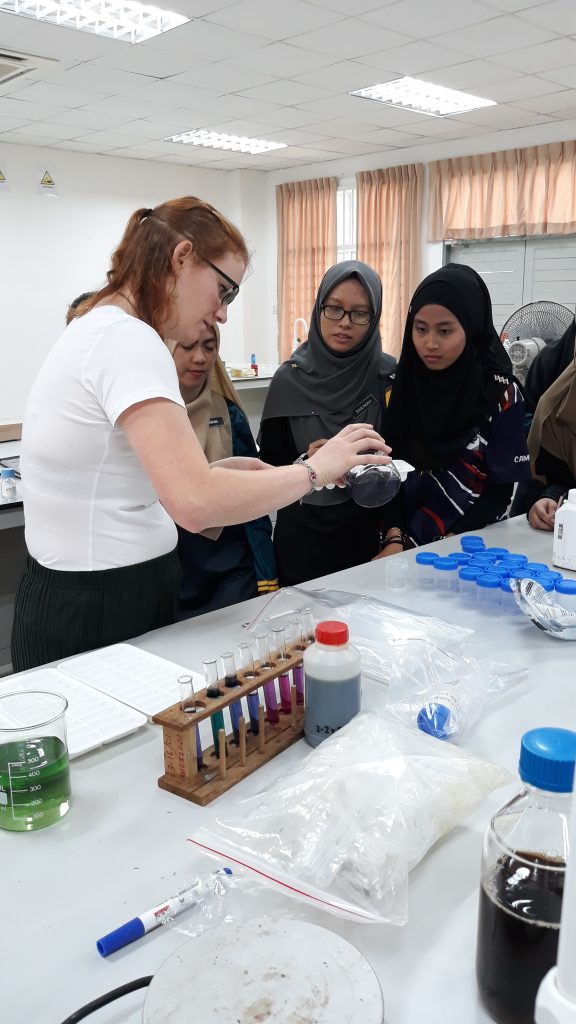
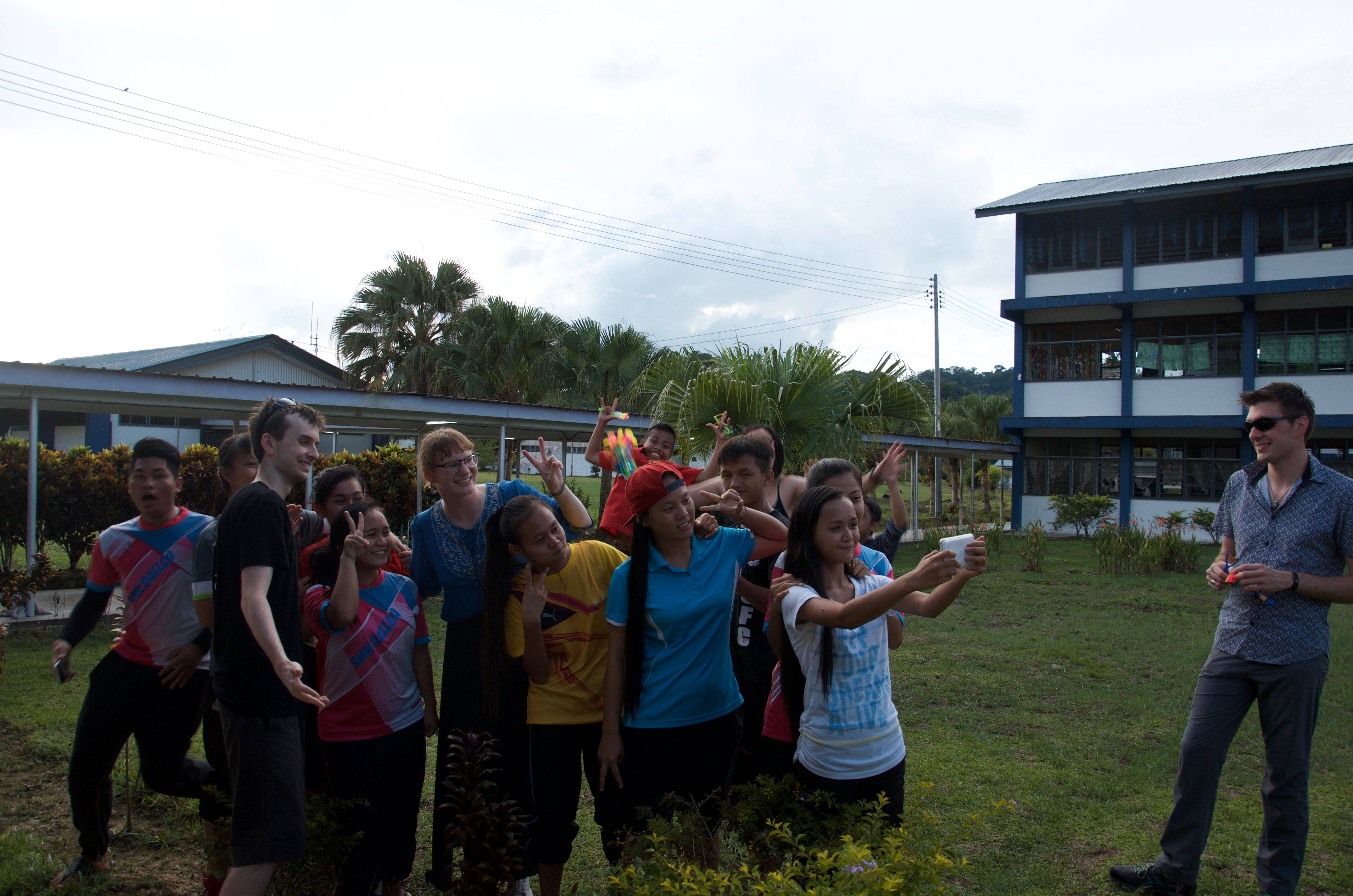

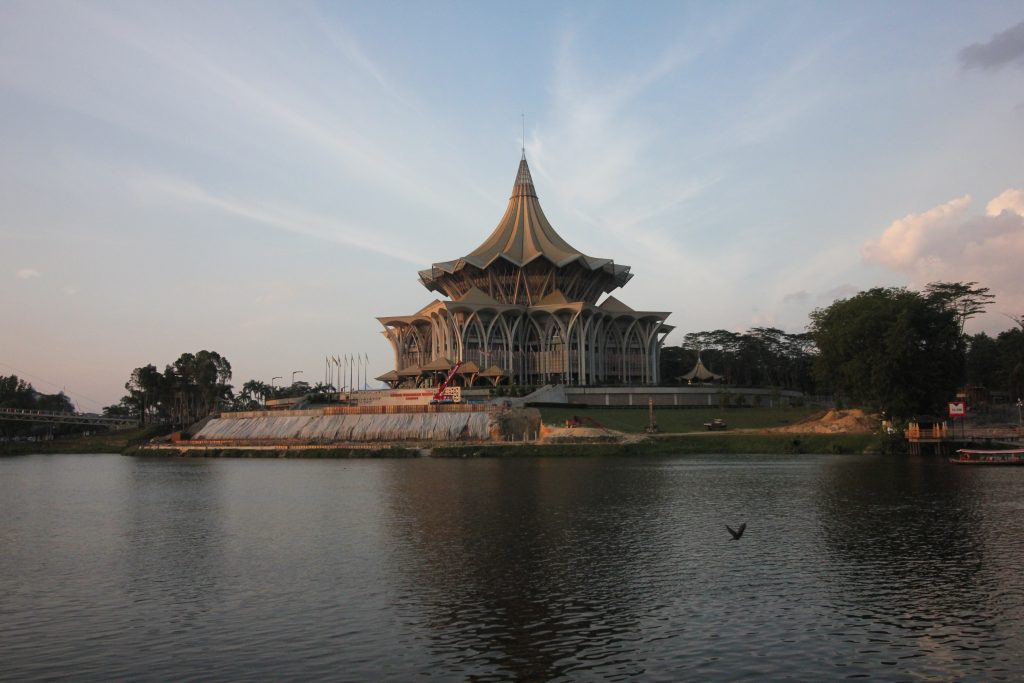
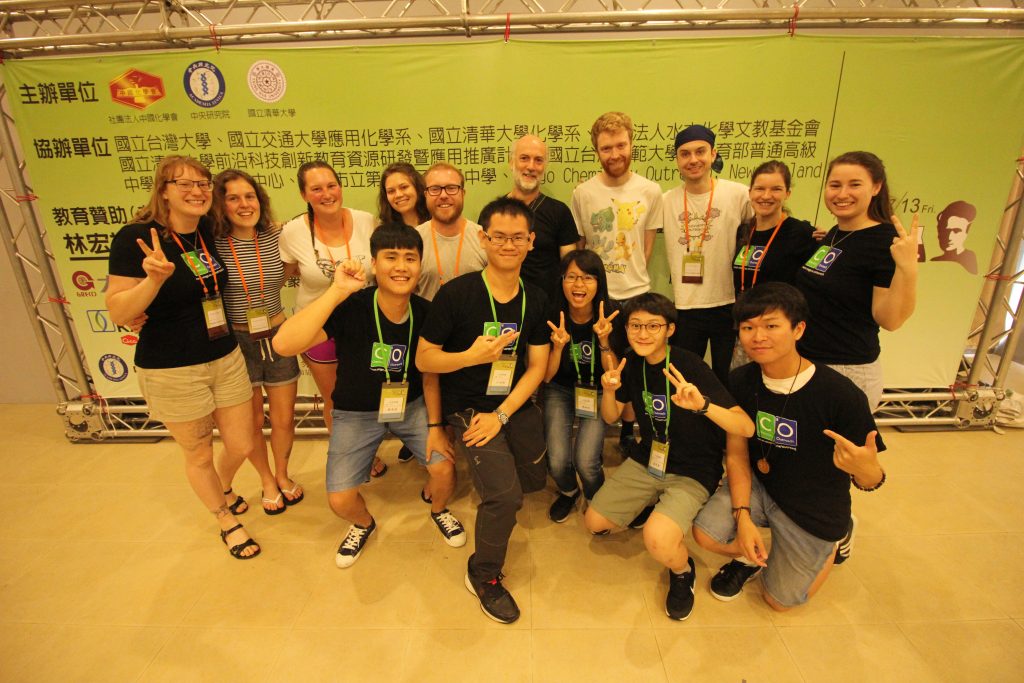
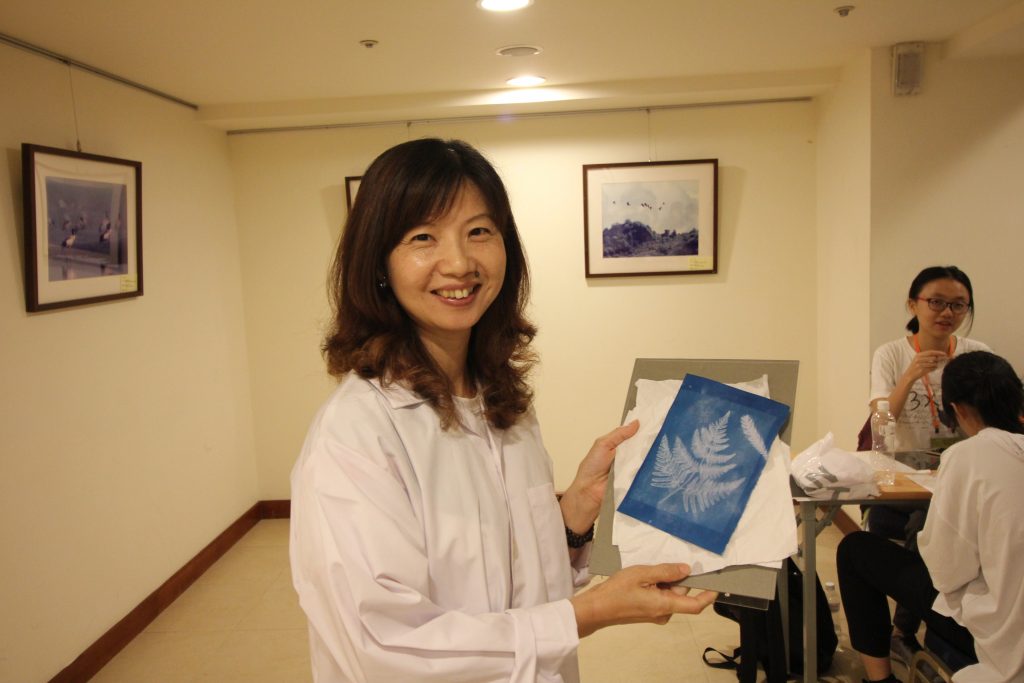
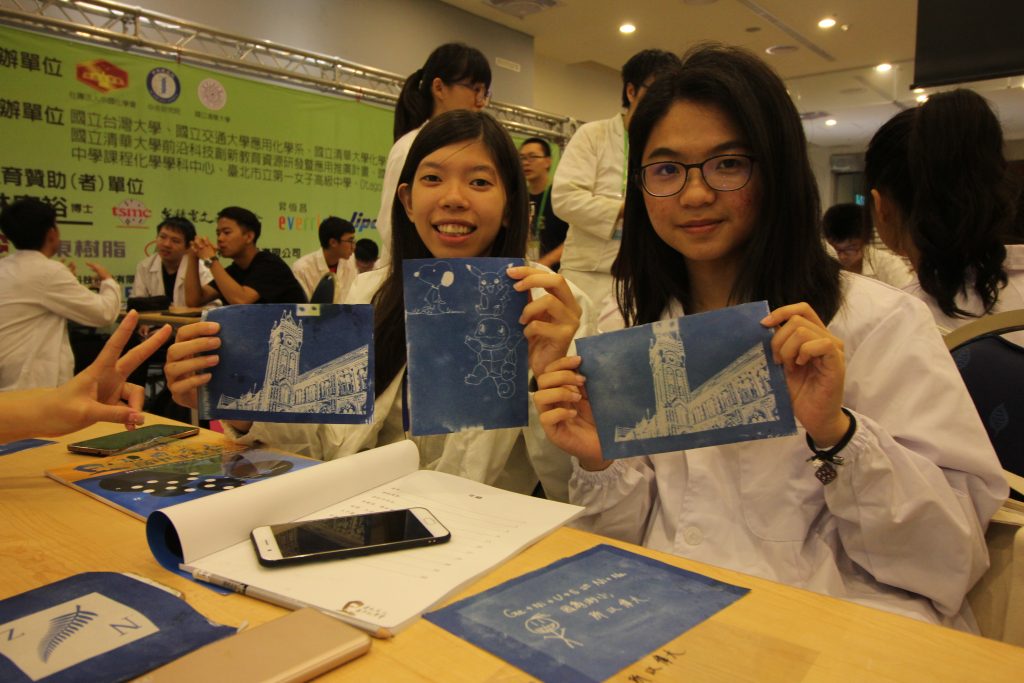
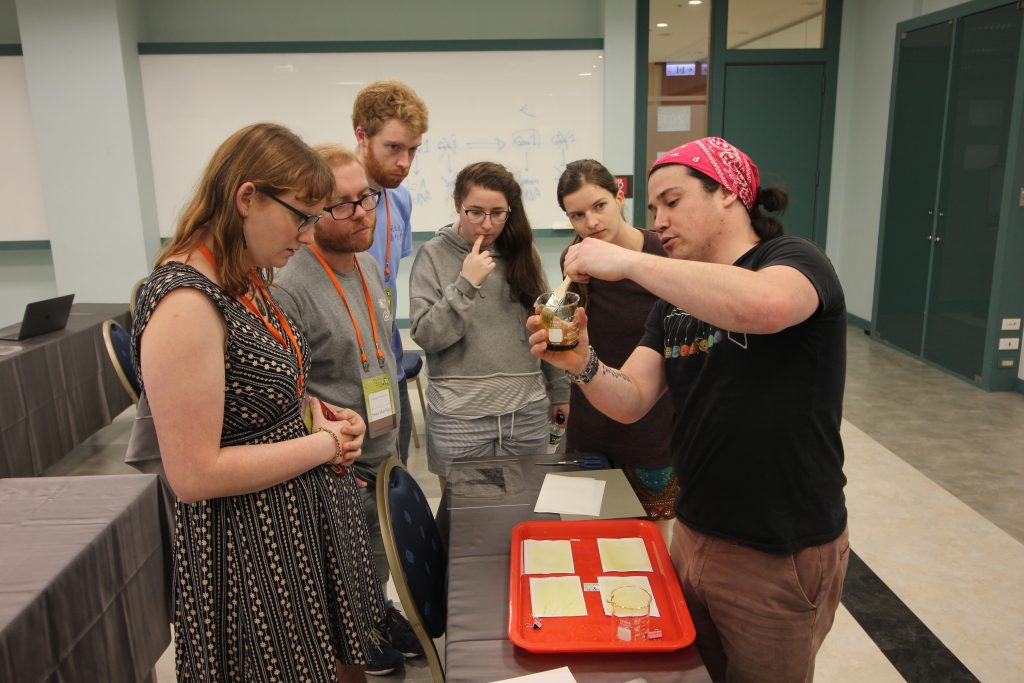

Recent comments